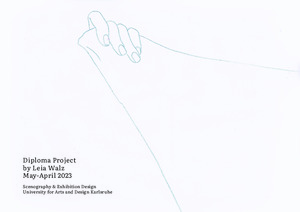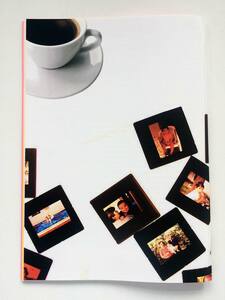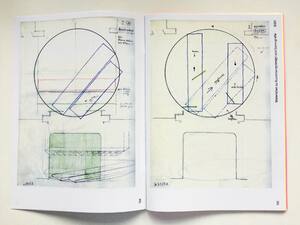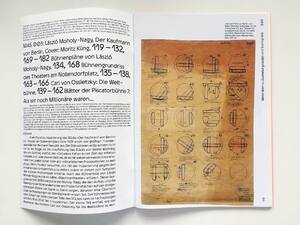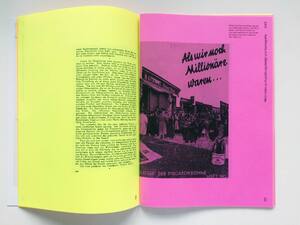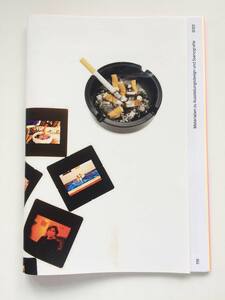"Darstellungspolitik"
| Begriff | Darstellungspolitik |
| Metakey | Schlagworte (madek_core:keywords) |
| Typ | Keyword |
| Vokabular | Madek Core |
6 Inhalte
- Seite 1 von 1
Diploma project documentation 01
- Titel
- Diploma project documentation 01
- Titel (en)
- an invitation to an exhibition in a laundry
- Autor/in
- Beschreibung (de)
- "eine einladung zu einer ausstellung in einer waschküche" fand in einer Waschküche und einem Hinterhof in Karlsruhe
statt, einem Raum, der bisher nur für private Zwecke genutzt wurde. Das 18-tägige Programm erzählt von der alltäglichen und manuellen Arbeit von Wäscher*innen und der Stigmatisierung, der sie ausgesetzt sind. Indes wird das Waschen der Wäsche ein Referenzraum für die Auseinandersetzung mit den Überschneidungen von Reproduktiver Arbeit und Lohnarbeit.
Das Programm basiert auf einer Recherche, die die Strukturen dieser Stadt, ihre versteckten und ungesehenen eschichten sowie die Verflechtungen von sozialen Rollen und Räumen untersucht. Material aus verschiedenen Archiven und Gesprächen wird in drei Faltblättern gebündelt: „erinnern“, „arbeiten“ und „zusammenkommen“. Die Ausstellung im Hinterhof und in der Waschküche ist verknüpft mit der Recherche und entstand sukzessive durch persönlichen und intimen Austausch mit Künstler*innen und Freund*innen, die an der Staatlichen Hochschule für Gestaltung Karlsruhe studieren und studiert haben. Sie setzen sich zu bestimmten Aspekten der Recherche und der Metapher des Waschens in Relation und lassen dadurch weitere Überschneidungen und Verweise zu.
- "eine einladung zu einer ausstellung in einer waschküche" fand in einer Waschküche und einem Hinterhof in Karlsruhe
- Beschreibung (en)
- The project took place in a laundry room and backyard in Karlsruhe, a space that has only been used for private purposes. The programme that lasted 18 days tells of common and manual work of washerwomen* and the stigma
they are exposed to. Doing the laundry becomes a reference space to engage with the intersection of care work and wage labour.
The programme is based on a research that draws attention to this very city‘s structure, its hidden and unseen stories as well as the crossing of social roles and spaces. Material from various archives and conversations is bundled in three leaflets: “remembering”, “working” and “coming together”. The research was accompanied by an exhibition. It gathered the voices of close friends and artists who study or have studied at the University of Arts and Design Karlsruhe. They were invited to respond to the research and contribute works that relate to specific aspects and the metaphor of washing. The exhibition successively resulted from these personal and intimate conversations and thereby allowed
further ramifications, intersections and references.
- The project took place in a laundry room and backyard in Karlsruhe, a space that has only been used for private purposes. The programme that lasted 18 days tells of common and manual work of washerwomen* and the stigma
- Typ des Projekts/Werks
- Schlagworte
- Datierung
- 26.04.2023 - 14.05.2023
- Mitwirkende
- Dank an
- Sprache
- Ort
- Privater Hinterhof und Waschküche in Karlsruhe
- Stadt
- Land
- Titel
- Diploma project documentation 01
- Urheberrechtshinweis
- Leia Walz
- Rechtsschutz/Lizenz
- Freigabe Nutzung HfG
- Importiert am
- 13.09.2023
- Übergeordnete Sets
- 1
MAS 003
- Titel
- MAS 003
- Untertitel
- László Moholy-Nagy, Der Kaufmann von Berlin
- Autor/in
- Beschreibung (de)
- Die dritte Ausgabe von ‚Materialien zu Ausstellungsdesign und Szenografie‘ ist der Bühnengestaltung von László Moholy-Nagy für Erwin Piscators Inszenierung des Stückes “Der Kaufmann von Berlin” von 1929 gewidmet. Die Inszenierung wurde nicht nur aufgrund der politischen Inhalte zum Skandal, auch die von der Presse als „Maschinentheater“ bezeichnete Szenografie erregte Aufsehen. Die formalen Mittel, die Moholy-Nagy in seinen Bühnenbildern für Piscator einsetzte – wie Laufbänder, mobile Stahlgestänge, Licht- und Schattenspiele, Film- und Diaprojektionen – übertrug er 1930 in seine „Ausstellungsszenografien“ für den Theaterbereich der Werkbundausstellung beim Salon des Arts Décoratifs in Paris sowie in seinen Entwurf des „Raums der Gegenwart“ für das Provinzialmuseum in Hannover. Die Radikalität von Moholy-Nagys Bühnenentwürfen geht aus den bekannten Szenenfotos von Lotte Jacobi kaum hervor. Daher umfasst das vorliegende Heft 28 von Moholy-Nagy gezeichnete Bühnenpläne, welche den bühnentechnischen Ablauf des Stückes nachvollziehbar machen, das Programmheft mit Umschlaggestaltung und Fotografien des Bühnenmodells ebenfalls von Moholy-Nagy, sowie eine ausführliche Rezension von Carl von Ossietzky, erschienen 1929 in der Weltbühne.
Der Umschlag des 3. MAS Heftes wurde von dem Kurator Moritz Küng gestaltet. Eingeladen auf dem Cover zum Begriff „Darstellungspolitik“ Stellung zu nehmen und inspiriert vom Titel des Magazins, musste Küng daran denken, wie sich vor rund 25 Jahren ein guter Freund – ein Anwalt für Mietrecht – bei ihm beklagte, dass er als leidenschaftlicher Fotograf eigentlich lieber Künstler geworden wäre. In einer Mischung aus Wehmut und Frustration kommentierte er im Schweizer Dialekt den Beruf des Kuratoren wie folgt: “Aber was machsch du eigentlech: Käffeli trinke, Zigarettli rauche ond Föteli luege”. Dementsprechend illustrierte Küng den Beruf des Kurators mit im Internet gefundenen Stock-Fotos (Kaffeetasse, Aschenbecher, Dias).
- Die dritte Ausgabe von ‚Materialien zu Ausstellungsdesign und Szenografie‘ ist der Bühnengestaltung von László Moholy-Nagy für Erwin Piscators Inszenierung des Stückes “Der Kaufmann von Berlin” von 1929 gewidmet. Die Inszenierung wurde nicht nur aufgrund der politischen Inhalte zum Skandal, auch die von der Presse als „Maschinentheater“ bezeichnete Szenografie erregte Aufsehen. Die formalen Mittel, die Moholy-Nagy in seinen Bühnenbildern für Piscator einsetzte – wie Laufbänder, mobile Stahlgestänge, Licht- und Schattenspiele, Film- und Diaprojektionen – übertrug er 1930 in seine „Ausstellungsszenografien“ für den Theaterbereich der Werkbundausstellung beim Salon des Arts Décoratifs in Paris sowie in seinen Entwurf des „Raums der Gegenwart“ für das Provinzialmuseum in Hannover. Die Radikalität von Moholy-Nagys Bühnenentwürfen geht aus den bekannten Szenenfotos von Lotte Jacobi kaum hervor. Daher umfasst das vorliegende Heft 28 von Moholy-Nagy gezeichnete Bühnenpläne, welche den bühnentechnischen Ablauf des Stückes nachvollziehbar machen, das Programmheft mit Umschlaggestaltung und Fotografien des Bühnenmodells ebenfalls von Moholy-Nagy, sowie eine ausführliche Rezension von Carl von Ossietzky, erschienen 1929 in der Weltbühne.
- Beschreibung (en)
- The third edition of 'Materials on Exhibition Design and Scenography' is dedicated to László Moholy-Nagy's stage design for Erwin Piscator's 1929 production of the play "The Merchant of Berlin". The production became a scandal not only because of its political content, but also because the scenography, which the press described as "machine theater", caused a sensation. The formal means that Moholy-Nagy used in his stage designs for Piscator - such as treadmills, mobile steel rods, plays of light and shadow, film and slide projections - were transferred to his "exhibition scenographies" for the theater section of the Werkbund exhibition at the Salon des Arts Décoratifs in Paris in 1930 and to his design of the "Raum der Gegenwart" for the Provinzialmuseum in Hanover. The radical nature of Moholy-Nagy's stage designs hardly emerges from the well-known scene photos by Lotte Jacobi. This booklet therefore contains 28 stage plans drawn by Moholy-Nagy, which make the technical stage sequence of the play comprehensible, the program booklet with cover design and photographs of the stage model, also by Moholy-Nagy, as well as a detailed review by Carl von Ossietzky, published in the Weltbühne in 1929.
The cover of the 3rd issue of MAS was designed by curator Moritz Küng. Invited to comment on the term "politics of representation" on the cover and inspired by the title of the magazine, Küng was reminded of how, around 25 years ago, a good friend - a lawyer specializing in tenancy law - complained to him that, as a passionate photographer, he would actually have preferred to become an artist. In a mixture of melancholy and frustration, he commented on the profession of curator in Swiss dialect as follows: "But what do you actually do: drink coffee, smoke cigarettes and listen to fiddles". Accordingly, Küng illustrated the curator's profession with stock photos found on the Internet (coffee cup, ashtray, slides).
- The third edition of 'Materials on Exhibition Design and Scenography' is dedicated to László Moholy-Nagy's stage design for Erwin Piscator's 1929 production of the play "The Merchant of Berlin". The production became a scandal not only because of its political content, but also because the scenography, which the press described as "machine theater", caused a sensation. The formal means that Moholy-Nagy used in his stage designs for Piscator - such as treadmills, mobile steel rods, plays of light and shadow, film and slide projections - were transferred to his "exhibition scenographies" for the theater section of the Werkbund exhibition at the Salon des Arts Décoratifs in Paris in 1930 and to his design of the "Raum der Gegenwart" for the Provinzialmuseum in Hanover. The radical nature of Moholy-Nagy's stage designs hardly emerges from the well-known scene photos by Lotte Jacobi. This booklet therefore contains 28 stage plans drawn by Moholy-Nagy, which make the technical stage sequence of the play comprehensible, the program booklet with cover design and photographs of the stage model, also by Moholy-Nagy, as well as a detailed review by Carl von Ossietzky, published in the Weltbühne in 1929.
- Typ des Projekts/Werks
- Schlagworte
- Mitwirkende
- Sprache
- Abmessungen
- DIN A4
- Ort: Institution
- Stadt
- Land
- Bemerkungen
- Heft 3: László Moholy-Nagy, Der Kaufmann von Berlin
68 Seiten
28 Abb., farbig
Cover: Moritz Küng
Abbildungen: Bühnenentwürfe von L. Moholy-Nagy, Programmheft der Piscator Bühne, Theaterwissenschaftliche Sammlung der Universität Köln
Grafik Credits: Johannes Hucht, Yannick Nuss
- Heft 3: László Moholy-Nagy, Der Kaufmann von Berlin
- Titel
- MAS 003
- Urheberrechtshinweis
- Fachbereich Ausstellungsdesign und Szenografie, HfG Karlsruhe; Cover: Moritz Küng; Grafik: Johannes Hucht, Yannick Nuss
- Rechtsschutz/Lizenz
- Beziehung/Funktion
- Projektleiter/in
- Semester
- Lehrveranstaltung
- Importiert am
- 24.05.2023
- Übergeordnete Sets
- 1
MAS 003
- Titel
- MAS 003
- Untertitel
- László Moholy-Nagy, Der Kaufmann von Berlin
- Autor/in
- Beschreibung (de)
- Die dritte Ausgabe von ‚Materialien zu Ausstellungsdesign und Szenografie‘ ist der Bühnengestaltung von László Moholy-Nagy für Erwin Piscators Inszenierung des Stückes “Der Kaufmann von Berlin” von 1929 gewidmet. Die Inszenierung wurde nicht nur aufgrund der politischen Inhalte zum Skandal, auch die von der Presse als „Maschinentheater“ bezeichnete Szenografie erregte Aufsehen. Die formalen Mittel, die Moholy-Nagy in seinen Bühnenbildern für Piscator einsetzte – wie Laufbänder, mobile Stahlgestänge, Licht- und Schattenspiele, Film- und Diaprojektionen – übertrug er 1930 in seine „Ausstellungsszenografien“ für den Theaterbereich der Werkbundausstellung beim Salon des Arts Décoratifs in Paris sowie in seinen Entwurf des „Raums der Gegenwart“ für das Provinzialmuseum in Hannover. Die Radikalität von Moholy-Nagys Bühnenentwürfen geht aus den bekannten Szenenfotos von Lotte Jacobi kaum hervor. Daher umfasst das vorliegende Heft 28 von Moholy-Nagy gezeichnete Bühnenpläne, welche den bühnentechnischen Ablauf des Stückes nachvollziehbar machen, das Programmheft mit Umschlaggestaltung und Fotografien des Bühnenmodells ebenfalls von Moholy-Nagy, sowie eine ausführliche Rezension von Carl von Ossietzky, erschienen 1929 in der Weltbühne.
Der Umschlag des 3. MAS Heftes wurde von dem Kurator Moritz Küng gestaltet. Eingeladen auf dem Cover zum Begriff „Darstellungspolitik“ Stellung zu nehmen und inspiriert vom Titel des Magazins, musste Küng daran denken, wie sich vor rund 25 Jahren ein guter Freund – ein Anwalt für Mietrecht – bei ihm beklagte, dass er als leidenschaftlicher Fotograf eigentlich lieber Künstler geworden wäre. In einer Mischung aus Wehmut und Frustration kommentierte er im Schweizer Dialekt den Beruf des Kuratoren wie folgt: “Aber was machsch du eigentlech: Käffeli trinke, Zigarettli rauche ond Föteli luege”. Dementsprechend illustrierte Küng den Beruf des Kurators mit im Internet gefundenen Stock-Fotos (Kaffeetasse, Aschenbecher, Dias).
- Die dritte Ausgabe von ‚Materialien zu Ausstellungsdesign und Szenografie‘ ist der Bühnengestaltung von László Moholy-Nagy für Erwin Piscators Inszenierung des Stückes “Der Kaufmann von Berlin” von 1929 gewidmet. Die Inszenierung wurde nicht nur aufgrund der politischen Inhalte zum Skandal, auch die von der Presse als „Maschinentheater“ bezeichnete Szenografie erregte Aufsehen. Die formalen Mittel, die Moholy-Nagy in seinen Bühnenbildern für Piscator einsetzte – wie Laufbänder, mobile Stahlgestänge, Licht- und Schattenspiele, Film- und Diaprojektionen – übertrug er 1930 in seine „Ausstellungsszenografien“ für den Theaterbereich der Werkbundausstellung beim Salon des Arts Décoratifs in Paris sowie in seinen Entwurf des „Raums der Gegenwart“ für das Provinzialmuseum in Hannover. Die Radikalität von Moholy-Nagys Bühnenentwürfen geht aus den bekannten Szenenfotos von Lotte Jacobi kaum hervor. Daher umfasst das vorliegende Heft 28 von Moholy-Nagy gezeichnete Bühnenpläne, welche den bühnentechnischen Ablauf des Stückes nachvollziehbar machen, das Programmheft mit Umschlaggestaltung und Fotografien des Bühnenmodells ebenfalls von Moholy-Nagy, sowie eine ausführliche Rezension von Carl von Ossietzky, erschienen 1929 in der Weltbühne.
- Beschreibung (en)
- The third edition of 'Materials on Exhibition Design and Scenography' is dedicated to László Moholy-Nagy's stage design for Erwin Piscator's 1929 production of the play "The Merchant of Berlin". The production became a scandal not only because of its political content, but also because the scenography, which the press described as "machine theater", caused a sensation. The formal means that Moholy-Nagy used in his stage designs for Piscator - such as treadmills, mobile steel rods, plays of light and shadow, film and slide projections - were transferred to his "exhibition scenographies" for the theater section of the Werkbund exhibition at the Salon des Arts Décoratifs in Paris in 1930 and to his design of the "Raum der Gegenwart" for the Provinzialmuseum in Hanover. The radical nature of Moholy-Nagy's stage designs hardly emerges from the well-known scene photos by Lotte Jacobi. This booklet therefore contains 28 stage plans drawn by Moholy-Nagy, which make the technical stage sequence of the play comprehensible, the program booklet with cover design and photographs of the stage model, also by Moholy-Nagy, as well as a detailed review by Carl von Ossietzky, published in the Weltbühne in 1929.
The cover of the 3rd issue of MAS was designed by curator Moritz Küng. Invited to comment on the term "politics of representation" on the cover and inspired by the title of the magazine, Küng was reminded of how, around 25 years ago, a good friend - a lawyer specializing in tenancy law - complained to him that, as a passionate photographer, he would actually have preferred to become an artist. In a mixture of melancholy and frustration, he commented on the profession of curator in Swiss dialect as follows: "But what do you actually do: drink coffee, smoke cigarettes and listen to fiddles". Accordingly, Küng illustrated the curator's profession with stock photos found on the Internet (coffee cup, ashtray, slides).
- The third edition of 'Materials on Exhibition Design and Scenography' is dedicated to László Moholy-Nagy's stage design for Erwin Piscator's 1929 production of the play "The Merchant of Berlin". The production became a scandal not only because of its political content, but also because the scenography, which the press described as "machine theater", caused a sensation. The formal means that Moholy-Nagy used in his stage designs for Piscator - such as treadmills, mobile steel rods, plays of light and shadow, film and slide projections - were transferred to his "exhibition scenographies" for the theater section of the Werkbund exhibition at the Salon des Arts Décoratifs in Paris in 1930 and to his design of the "Raum der Gegenwart" for the Provinzialmuseum in Hanover. The radical nature of Moholy-Nagy's stage designs hardly emerges from the well-known scene photos by Lotte Jacobi. This booklet therefore contains 28 stage plans drawn by Moholy-Nagy, which make the technical stage sequence of the play comprehensible, the program booklet with cover design and photographs of the stage model, also by Moholy-Nagy, as well as a detailed review by Carl von Ossietzky, published in the Weltbühne in 1929.
- Typ des Projekts/Werks
- Schlagworte
- Mitwirkende
- Sprache
- Abmessungen
- DIN A4
- Ort: Institution
- Stadt
- Land
- Bemerkungen
- Heft 3: László Moholy-Nagy, Der Kaufmann von Berlin
68 Seiten
28 Abb., farbig
Cover: Moritz Küng
Abbildungen: Bühnenentwürfe von L. Moholy-Nagy, Programmheft der Piscator Bühne, Theaterwissenschaftliche Sammlung der Universität Köln
Grafik Credits: Johannes Hucht, Yannick Nuss
- Heft 3: László Moholy-Nagy, Der Kaufmann von Berlin
- Titel
- MAS 003
- Urheberrechtshinweis
- Fachbereich Ausstellungsdesign und Szenografie, HfG Karlsruhe; Cover: Moritz Küng; Grafik: Johannes Hucht, Yannick Nuss
- Rechtsschutz/Lizenz
- Beziehung/Funktion
- Projektleiter/in
- Semester
- Lehrveranstaltung
- Importiert am
- 24.05.2023
- Übergeordnete Sets
- 1
MAS 003
- Titel
- MAS 003
- Untertitel
- László Moholy-Nagy, Der Kaufmann von Berlin
- Autor/in
- Beschreibung (de)
- Die dritte Ausgabe von ‚Materialien zu Ausstellungsdesign und Szenografie‘ ist der Bühnengestaltung von László Moholy-Nagy für Erwin Piscators Inszenierung des Stückes “Der Kaufmann von Berlin” von 1929 gewidmet. Die Inszenierung wurde nicht nur aufgrund der politischen Inhalte zum Skandal, auch die von der Presse als „Maschinentheater“ bezeichnete Szenografie erregte Aufsehen. Die formalen Mittel, die Moholy-Nagy in seinen Bühnenbildern für Piscator einsetzte – wie Laufbänder, mobile Stahlgestänge, Licht- und Schattenspiele, Film- und Diaprojektionen – übertrug er 1930 in seine „Ausstellungsszenografien“ für den Theaterbereich der Werkbundausstellung beim Salon des Arts Décoratifs in Paris sowie in seinen Entwurf des „Raums der Gegenwart“ für das Provinzialmuseum in Hannover. Die Radikalität von Moholy-Nagys Bühnenentwürfen geht aus den bekannten Szenenfotos von Lotte Jacobi kaum hervor. Daher umfasst das vorliegende Heft 28 von Moholy-Nagy gezeichnete Bühnenpläne, welche den bühnentechnischen Ablauf des Stückes nachvollziehbar machen, das Programmheft mit Umschlaggestaltung und Fotografien des Bühnenmodells ebenfalls von Moholy-Nagy, sowie eine ausführliche Rezension von Carl von Ossietzky, erschienen 1929 in der Weltbühne.
Der Umschlag des 3. MAS Heftes wurde von dem Kurator Moritz Küng gestaltet. Eingeladen auf dem Cover zum Begriff „Darstellungspolitik“ Stellung zu nehmen und inspiriert vom Titel des Magazins, musste Küng daran denken, wie sich vor rund 25 Jahren ein guter Freund – ein Anwalt für Mietrecht – bei ihm beklagte, dass er als leidenschaftlicher Fotograf eigentlich lieber Künstler geworden wäre. In einer Mischung aus Wehmut und Frustration kommentierte er im Schweizer Dialekt den Beruf des Kuratoren wie folgt: “Aber was machsch du eigentlech: Käffeli trinke, Zigarettli rauche ond Föteli luege”. Dementsprechend illustrierte Küng den Beruf des Kurators mit im Internet gefundenen Stock-Fotos (Kaffeetasse, Aschenbecher, Dias).
- Die dritte Ausgabe von ‚Materialien zu Ausstellungsdesign und Szenografie‘ ist der Bühnengestaltung von László Moholy-Nagy für Erwin Piscators Inszenierung des Stückes “Der Kaufmann von Berlin” von 1929 gewidmet. Die Inszenierung wurde nicht nur aufgrund der politischen Inhalte zum Skandal, auch die von der Presse als „Maschinentheater“ bezeichnete Szenografie erregte Aufsehen. Die formalen Mittel, die Moholy-Nagy in seinen Bühnenbildern für Piscator einsetzte – wie Laufbänder, mobile Stahlgestänge, Licht- und Schattenspiele, Film- und Diaprojektionen – übertrug er 1930 in seine „Ausstellungsszenografien“ für den Theaterbereich der Werkbundausstellung beim Salon des Arts Décoratifs in Paris sowie in seinen Entwurf des „Raums der Gegenwart“ für das Provinzialmuseum in Hannover. Die Radikalität von Moholy-Nagys Bühnenentwürfen geht aus den bekannten Szenenfotos von Lotte Jacobi kaum hervor. Daher umfasst das vorliegende Heft 28 von Moholy-Nagy gezeichnete Bühnenpläne, welche den bühnentechnischen Ablauf des Stückes nachvollziehbar machen, das Programmheft mit Umschlaggestaltung und Fotografien des Bühnenmodells ebenfalls von Moholy-Nagy, sowie eine ausführliche Rezension von Carl von Ossietzky, erschienen 1929 in der Weltbühne.
- Beschreibung (en)
- The third edition of 'Materials on Exhibition Design and Scenography' is dedicated to László Moholy-Nagy's stage design for Erwin Piscator's 1929 production of the play "The Merchant of Berlin". The production became a scandal not only because of its political content, but also because the scenography, which the press described as "machine theater", caused a sensation. The formal means that Moholy-Nagy used in his stage designs for Piscator - such as treadmills, mobile steel rods, plays of light and shadow, film and slide projections - were transferred to his "exhibition scenographies" for the theater section of the Werkbund exhibition at the Salon des Arts Décoratifs in Paris in 1930 and to his design of the "Raum der Gegenwart" for the Provinzialmuseum in Hanover. The radical nature of Moholy-Nagy's stage designs hardly emerges from the well-known scene photos by Lotte Jacobi. This booklet therefore contains 28 stage plans drawn by Moholy-Nagy, which make the technical stage sequence of the play comprehensible, the program booklet with cover design and photographs of the stage model, also by Moholy-Nagy, as well as a detailed review by Carl von Ossietzky, published in the Weltbühne in 1929.
The cover of the 3rd issue of MAS was designed by curator Moritz Küng. Invited to comment on the term "politics of representation" on the cover and inspired by the title of the magazine, Küng was reminded of how, around 25 years ago, a good friend - a lawyer specializing in tenancy law - complained to him that, as a passionate photographer, he would actually have preferred to become an artist. In a mixture of melancholy and frustration, he commented on the profession of curator in Swiss dialect as follows: "But what do you actually do: drink coffee, smoke cigarettes and listen to fiddles". Accordingly, Küng illustrated the curator's profession with stock photos found on the Internet (coffee cup, ashtray, slides).
- The third edition of 'Materials on Exhibition Design and Scenography' is dedicated to László Moholy-Nagy's stage design for Erwin Piscator's 1929 production of the play "The Merchant of Berlin". The production became a scandal not only because of its political content, but also because the scenography, which the press described as "machine theater", caused a sensation. The formal means that Moholy-Nagy used in his stage designs for Piscator - such as treadmills, mobile steel rods, plays of light and shadow, film and slide projections - were transferred to his "exhibition scenographies" for the theater section of the Werkbund exhibition at the Salon des Arts Décoratifs in Paris in 1930 and to his design of the "Raum der Gegenwart" for the Provinzialmuseum in Hanover. The radical nature of Moholy-Nagy's stage designs hardly emerges from the well-known scene photos by Lotte Jacobi. This booklet therefore contains 28 stage plans drawn by Moholy-Nagy, which make the technical stage sequence of the play comprehensible, the program booklet with cover design and photographs of the stage model, also by Moholy-Nagy, as well as a detailed review by Carl von Ossietzky, published in the Weltbühne in 1929.
- Typ des Projekts/Werks
- Schlagworte
- Mitwirkende
- Sprache
- Abmessungen
- DIN A4
- Ort: Institution
- Stadt
- Land
- Bemerkungen
- Heft 3: László Moholy-Nagy, Der Kaufmann von Berlin
68 Seiten
28 Abb., farbig
Cover: Moritz Küng
Abbildungen: Bühnenentwürfe von L. Moholy-Nagy, Programmheft der Piscator Bühne, Theaterwissenschaftliche Sammlung der Universität Köln
Grafik Credits: Johannes Hucht, Yannick Nuss
- Heft 3: László Moholy-Nagy, Der Kaufmann von Berlin
- Titel
- MAS 003
- Urheberrechtshinweis
- Fachbereich Ausstellungsdesign und Szenografie, HfG Karlsruhe; Cover: Moritz Küng; Grafik: Johannes Hucht, Yannick Nuss
- Rechtsschutz/Lizenz
- Beziehung/Funktion
- Projektleiter/in
- Semester
- Lehrveranstaltung
- Importiert am
- 24.05.2023
- Übergeordnete Sets
- 1
MAS 003
- Titel
- MAS 003
- Untertitel
- László Moholy-Nagy, Der Kaufmann von Berlin
- Autor/in
- Beschreibung (de)
- Die dritte Ausgabe von ‚Materialien zu Ausstellungsdesign und Szenografie‘ ist der Bühnengestaltung von László Moholy-Nagy für Erwin Piscators Inszenierung des Stückes “Der Kaufmann von Berlin” von 1929 gewidmet. Die Inszenierung wurde nicht nur aufgrund der politischen Inhalte zum Skandal, auch die von der Presse als „Maschinentheater“ bezeichnete Szenografie erregte Aufsehen. Die formalen Mittel, die Moholy-Nagy in seinen Bühnenbildern für Piscator einsetzte – wie Laufbänder, mobile Stahlgestänge, Licht- und Schattenspiele, Film- und Diaprojektionen – übertrug er 1930 in seine „Ausstellungsszenografien“ für den Theaterbereich der Werkbundausstellung beim Salon des Arts Décoratifs in Paris sowie in seinen Entwurf des „Raums der Gegenwart“ für das Provinzialmuseum in Hannover. Die Radikalität von Moholy-Nagys Bühnenentwürfen geht aus den bekannten Szenenfotos von Lotte Jacobi kaum hervor. Daher umfasst das vorliegende Heft 28 von Moholy-Nagy gezeichnete Bühnenpläne, welche den bühnentechnischen Ablauf des Stückes nachvollziehbar machen, das Programmheft mit Umschlaggestaltung und Fotografien des Bühnenmodells ebenfalls von Moholy-Nagy, sowie eine ausführliche Rezension von Carl von Ossietzky, erschienen 1929 in der Weltbühne.
Der Umschlag des 3. MAS Heftes wurde von dem Kurator Moritz Küng gestaltet. Eingeladen auf dem Cover zum Begriff „Darstellungspolitik“ Stellung zu nehmen und inspiriert vom Titel des Magazins, musste Küng daran denken, wie sich vor rund 25 Jahren ein guter Freund – ein Anwalt für Mietrecht – bei ihm beklagte, dass er als leidenschaftlicher Fotograf eigentlich lieber Künstler geworden wäre. In einer Mischung aus Wehmut und Frustration kommentierte er im Schweizer Dialekt den Beruf des Kuratoren wie folgt: “Aber was machsch du eigentlech: Käffeli trinke, Zigarettli rauche ond Föteli luege”. Dementsprechend illustrierte Küng den Beruf des Kurators mit im Internet gefundenen Stock-Fotos (Kaffeetasse, Aschenbecher, Dias).
- Die dritte Ausgabe von ‚Materialien zu Ausstellungsdesign und Szenografie‘ ist der Bühnengestaltung von László Moholy-Nagy für Erwin Piscators Inszenierung des Stückes “Der Kaufmann von Berlin” von 1929 gewidmet. Die Inszenierung wurde nicht nur aufgrund der politischen Inhalte zum Skandal, auch die von der Presse als „Maschinentheater“ bezeichnete Szenografie erregte Aufsehen. Die formalen Mittel, die Moholy-Nagy in seinen Bühnenbildern für Piscator einsetzte – wie Laufbänder, mobile Stahlgestänge, Licht- und Schattenspiele, Film- und Diaprojektionen – übertrug er 1930 in seine „Ausstellungsszenografien“ für den Theaterbereich der Werkbundausstellung beim Salon des Arts Décoratifs in Paris sowie in seinen Entwurf des „Raums der Gegenwart“ für das Provinzialmuseum in Hannover. Die Radikalität von Moholy-Nagys Bühnenentwürfen geht aus den bekannten Szenenfotos von Lotte Jacobi kaum hervor. Daher umfasst das vorliegende Heft 28 von Moholy-Nagy gezeichnete Bühnenpläne, welche den bühnentechnischen Ablauf des Stückes nachvollziehbar machen, das Programmheft mit Umschlaggestaltung und Fotografien des Bühnenmodells ebenfalls von Moholy-Nagy, sowie eine ausführliche Rezension von Carl von Ossietzky, erschienen 1929 in der Weltbühne.
- Beschreibung (en)
- The third edition of 'Materials on Exhibition Design and Scenography' is dedicated to László Moholy-Nagy's stage design for Erwin Piscator's 1929 production of the play "The Merchant of Berlin". The production became a scandal not only because of its political content, but also because the scenography, which the press described as "machine theater", caused a sensation. The formal means that Moholy-Nagy used in his stage designs for Piscator - such as treadmills, mobile steel rods, plays of light and shadow, film and slide projections - were transferred to his "exhibition scenographies" for the theater section of the Werkbund exhibition at the Salon des Arts Décoratifs in Paris in 1930 and to his design of the "Raum der Gegenwart" for the Provinzialmuseum in Hanover. The radical nature of Moholy-Nagy's stage designs hardly emerges from the well-known scene photos by Lotte Jacobi. This booklet therefore contains 28 stage plans drawn by Moholy-Nagy, which make the technical stage sequence of the play comprehensible, the program booklet with cover design and photographs of the stage model, also by Moholy-Nagy, as well as a detailed review by Carl von Ossietzky, published in the Weltbühne in 1929.
The cover of the 3rd issue of MAS was designed by curator Moritz Küng. Invited to comment on the term "politics of representation" on the cover and inspired by the title of the magazine, Küng was reminded of how, around 25 years ago, a good friend - a lawyer specializing in tenancy law - complained to him that, as a passionate photographer, he would actually have preferred to become an artist. In a mixture of melancholy and frustration, he commented on the profession of curator in Swiss dialect as follows: "But what do you actually do: drink coffee, smoke cigarettes and listen to fiddles". Accordingly, Küng illustrated the curator's profession with stock photos found on the Internet (coffee cup, ashtray, slides).
- The third edition of 'Materials on Exhibition Design and Scenography' is dedicated to László Moholy-Nagy's stage design for Erwin Piscator's 1929 production of the play "The Merchant of Berlin". The production became a scandal not only because of its political content, but also because the scenography, which the press described as "machine theater", caused a sensation. The formal means that Moholy-Nagy used in his stage designs for Piscator - such as treadmills, mobile steel rods, plays of light and shadow, film and slide projections - were transferred to his "exhibition scenographies" for the theater section of the Werkbund exhibition at the Salon des Arts Décoratifs in Paris in 1930 and to his design of the "Raum der Gegenwart" for the Provinzialmuseum in Hanover. The radical nature of Moholy-Nagy's stage designs hardly emerges from the well-known scene photos by Lotte Jacobi. This booklet therefore contains 28 stage plans drawn by Moholy-Nagy, which make the technical stage sequence of the play comprehensible, the program booklet with cover design and photographs of the stage model, also by Moholy-Nagy, as well as a detailed review by Carl von Ossietzky, published in the Weltbühne in 1929.
- Typ des Projekts/Werks
- Schlagworte
- Mitwirkende
- Sprache
- Abmessungen
- DIN A4
- Ort: Institution
- Stadt
- Land
- Bemerkungen
- Heft 3: László Moholy-Nagy, Der Kaufmann von Berlin
68 Seiten
28 Abb., farbig
Cover: Moritz Küng
Abbildungen: Bühnenentwürfe von L. Moholy-Nagy, Programmheft der Piscator Bühne, Theaterwissenschaftliche Sammlung der Universität Köln
Grafik Credits: Johannes Hucht, Yannick Nuss
- Heft 3: László Moholy-Nagy, Der Kaufmann von Berlin
- Titel
- MAS 003
- Urheberrechtshinweis
- Fachbereich Ausstellungsdesign und Szenografie, HfG Karlsruhe; Cover: Moritz Küng; Grafik: Johannes Hucht, Yannick Nuss
- Rechtsschutz/Lizenz
- Beziehung/Funktion
- Projektleiter/in
- Semester
- Lehrveranstaltung
- Importiert am
- 24.05.2023
- Übergeordnete Sets
- 1
MAS 003
- Titel
- MAS 003
- Untertitel
- László Moholy-Nagy, Der Kaufmann von Berlin
- Autor/in
- Beschreibung (de)
- Die dritte Ausgabe von ‚Materialien zu Ausstellungsdesign und Szenografie‘ ist der Bühnengestaltung von László Moholy-Nagy für Erwin Piscators Inszenierung des Stückes “Der Kaufmann von Berlin” von 1929 gewidmet. Die Inszenierung wurde nicht nur aufgrund der politischen Inhalte zum Skandal, auch die von der Presse als „Maschinentheater“ bezeichnete Szenografie erregte Aufsehen. Die formalen Mittel, die Moholy-Nagy in seinen Bühnenbildern für Piscator einsetzte – wie Laufbänder, mobile Stahlgestänge, Licht- und Schattenspiele, Film- und Diaprojektionen – übertrug er 1930 in seine „Ausstellungsszenografien“ für den Theaterbereich der Werkbundausstellung beim Salon des Arts Décoratifs in Paris sowie in seinen Entwurf des „Raums der Gegenwart“ für das Provinzialmuseum in Hannover. Die Radikalität von Moholy-Nagys Bühnenentwürfen geht aus den bekannten Szenenfotos von Lotte Jacobi kaum hervor. Daher umfasst das vorliegende Heft 28 von Moholy-Nagy gezeichnete Bühnenpläne, welche den bühnentechnischen Ablauf des Stückes nachvollziehbar machen, das Programmheft mit Umschlaggestaltung und Fotografien des Bühnenmodells ebenfalls von Moholy-Nagy, sowie eine ausführliche Rezension von Carl von Ossietzky, erschienen 1929 in der Weltbühne.
Der Umschlag des 3. MAS Heftes wurde von dem Kurator Moritz Küng gestaltet. Eingeladen auf dem Cover zum Begriff „Darstellungspolitik“ Stellung zu nehmen und inspiriert vom Titel des Magazins, musste Küng daran denken, wie sich vor rund 25 Jahren ein guter Freund – ein Anwalt für Mietrecht – bei ihm beklagte, dass er als leidenschaftlicher Fotograf eigentlich lieber Künstler geworden wäre. In einer Mischung aus Wehmut und Frustration kommentierte er im Schweizer Dialekt den Beruf des Kuratoren wie folgt: “Aber was machsch du eigentlech: Käffeli trinke, Zigarettli rauche ond Föteli luege”. Dementsprechend illustrierte Küng den Beruf des Kurators mit im Internet gefundenen Stock-Fotos (Kaffeetasse, Aschenbecher, Dias).
- Die dritte Ausgabe von ‚Materialien zu Ausstellungsdesign und Szenografie‘ ist der Bühnengestaltung von László Moholy-Nagy für Erwin Piscators Inszenierung des Stückes “Der Kaufmann von Berlin” von 1929 gewidmet. Die Inszenierung wurde nicht nur aufgrund der politischen Inhalte zum Skandal, auch die von der Presse als „Maschinentheater“ bezeichnete Szenografie erregte Aufsehen. Die formalen Mittel, die Moholy-Nagy in seinen Bühnenbildern für Piscator einsetzte – wie Laufbänder, mobile Stahlgestänge, Licht- und Schattenspiele, Film- und Diaprojektionen – übertrug er 1930 in seine „Ausstellungsszenografien“ für den Theaterbereich der Werkbundausstellung beim Salon des Arts Décoratifs in Paris sowie in seinen Entwurf des „Raums der Gegenwart“ für das Provinzialmuseum in Hannover. Die Radikalität von Moholy-Nagys Bühnenentwürfen geht aus den bekannten Szenenfotos von Lotte Jacobi kaum hervor. Daher umfasst das vorliegende Heft 28 von Moholy-Nagy gezeichnete Bühnenpläne, welche den bühnentechnischen Ablauf des Stückes nachvollziehbar machen, das Programmheft mit Umschlaggestaltung und Fotografien des Bühnenmodells ebenfalls von Moholy-Nagy, sowie eine ausführliche Rezension von Carl von Ossietzky, erschienen 1929 in der Weltbühne.
- Beschreibung (en)
- The third edition of 'Materials on Exhibition Design and Scenography' is dedicated to László Moholy-Nagy's stage design for Erwin Piscator's 1929 production of the play "The Merchant of Berlin". The production became a scandal not only because of its political content, but also because the scenography, which the press described as "machine theater", caused a sensation. The formal means that Moholy-Nagy used in his stage designs for Piscator - such as treadmills, mobile steel rods, plays of light and shadow, film and slide projections - were transferred to his "exhibition scenographies" for the theater section of the Werkbund exhibition at the Salon des Arts Décoratifs in Paris in 1930 and to his design of the "Raum der Gegenwart" for the Provinzialmuseum in Hanover. The radical nature of Moholy-Nagy's stage designs hardly emerges from the well-known scene photos by Lotte Jacobi. This booklet therefore contains 28 stage plans drawn by Moholy-Nagy, which make the technical stage sequence of the play comprehensible, the program booklet with cover design and photographs of the stage model, also by Moholy-Nagy, as well as a detailed review by Carl von Ossietzky, published in the Weltbühne in 1929.
The cover of the 3rd issue of MAS was designed by curator Moritz Küng. Invited to comment on the term "politics of representation" on the cover and inspired by the title of the magazine, Küng was reminded of how, around 25 years ago, a good friend - a lawyer specializing in tenancy law - complained to him that, as a passionate photographer, he would actually have preferred to become an artist. In a mixture of melancholy and frustration, he commented on the profession of curator in Swiss dialect as follows: "But what do you actually do: drink coffee, smoke cigarettes and listen to fiddles". Accordingly, Küng illustrated the curator's profession with stock photos found on the Internet (coffee cup, ashtray, slides).
- The third edition of 'Materials on Exhibition Design and Scenography' is dedicated to László Moholy-Nagy's stage design for Erwin Piscator's 1929 production of the play "The Merchant of Berlin". The production became a scandal not only because of its political content, but also because the scenography, which the press described as "machine theater", caused a sensation. The formal means that Moholy-Nagy used in his stage designs for Piscator - such as treadmills, mobile steel rods, plays of light and shadow, film and slide projections - were transferred to his "exhibition scenographies" for the theater section of the Werkbund exhibition at the Salon des Arts Décoratifs in Paris in 1930 and to his design of the "Raum der Gegenwart" for the Provinzialmuseum in Hanover. The radical nature of Moholy-Nagy's stage designs hardly emerges from the well-known scene photos by Lotte Jacobi. This booklet therefore contains 28 stage plans drawn by Moholy-Nagy, which make the technical stage sequence of the play comprehensible, the program booklet with cover design and photographs of the stage model, also by Moholy-Nagy, as well as a detailed review by Carl von Ossietzky, published in the Weltbühne in 1929.
- Typ des Projekts/Werks
- Schlagworte
- Mitwirkende
- Sprache
- Abmessungen
- DIN A4
- Ort: Institution
- Stadt
- Land
- Bemerkungen
- Heft 3: László Moholy-Nagy, Der Kaufmann von Berlin
68 Seiten
28 Abb., farbig
Cover: Moritz Küng
Abbildungen: Bühnenentwürfe von L. Moholy-Nagy, Programmheft der Piscator Bühne, Theaterwissenschaftliche Sammlung der Universität Köln
Grafik Credits: Johannes Hucht, Yannick Nuss
- Heft 3: László Moholy-Nagy, Der Kaufmann von Berlin
- Titel
- MAS 003
- Urheberrechtshinweis
- Fachbereich Ausstellungsdesign und Szenografie, HfG Karlsruhe; Cover: Moritz Küng; Grafik: Johannes Hucht, Yannick Nuss
- Rechtsschutz/Lizenz
- Beziehung/Funktion
- Projektleiter/in
- Semester
- Lehrveranstaltung
- Importiert am
- 24.05.2023
- Übergeordnete Sets
- 1
